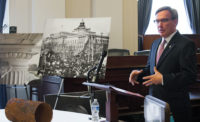“There are other colors than black,” says British architect Richard Rogers, who has a wardrobe as colorful as his personality. “And I don’t mind if people build in all white. But I do use bright colors.”
The colorful pipes and tubes—red for hot water and blue for HVAC—of his breakout work, the 1977 Centre Pompidou in Paris, designed with Renzo Piano, spring immediately to mind, as do the various shades of red adorning steel members at NEO Bankside in London (2012), the new Spy Museum in Washington, D.C., or the Patscentre in Princeton (1984). Rogers, whose firm rebranded as Rogers Stirk Harbour + Partners in 2007—the year he won the Pritzker Architecture Prize— has accumulated an impressive array of awards, including RIBA Stirling Prizes in 2006 for Madrid’s Barajas Airport, and in 2009 for a London Maggie’s Centre; the latter is rendered in a deep orange, and the former uses a whole spectrum to differentiate the various terminals. To these awards and hues, he now adds the AIA Gold Medal.
Reached by telephone following the award announcement, Rogers talked about sustainability and climate change, the growth and density of cities, and the architect’s role as problem-solver.
With such a breadth of work over your long career, do you have a favorite project?
It is very much like picking a favorite child, so it can be hard. Each one has its own attributes, positive and negative. The Pompidou certainly brought me the most fame, and its great piazza is very popular in Paris. I had a wonderful partner in Renzo Piano, and I had a terrific engineer, [the late] Peter Rice of Ove Arup & Partners.
On the other hand, projects like the Patscentre, and others of the same group, were wonderful engineering and architectural buildings. I remember being bowled over when I first arrived in New York, seeing these really industrial plants with all these pipes, and there’d constantly be engineers changing them. And I think that’s what buildings are: they’re constantly changing. When we did Lloyd’s of London [1986], it was about the fourth-tallest building in London, and now it’s about the fourth smallest. That’s about the speed of change.
Since the Pompidou, there’s been a trend in your work toward offices, airports, and urban plans. Is there a reason for the shift?
To me, urban planning, which is the most public problem to solve, if you like, has tremendous impact on the way you live, on how a city lives. Cities and urban planning are close to my heart. If your city is compact, you’ve already saved a quarter of all energy, so you have less climate change. And there are many other reasons, like people getting together. I never understand why architecture is so separated from urban planning. The two need to be linked, as they’re just two different scales of building.
Where do you see architecture heading to embrace sustainable methodologies?
I do believe, unlike your president, we have a crisis of climate change. I think that is one of the most dramatic problems mankind is facing, and probably has ever faced. Architecture, in a way, is about problem-solving. We have to put less CO2 into the air. I think we do have a role as human beings, let alone as architects, to reduce and be more efficient. And we must think about transportation: scooters are a big thing, even over here. They’re really tiny! They look like roller skates. There’s no logic in using large cars once we’ve mastered the way to use less energy in smaller modules. And we’ll have all that space once used for roads for more useful things, like getting coffee.
As cities become more crowded and suburban ways of living are no longer viable, in terms of their affect on climate change, how do you see housing changing?
If you’re going to build new towns, or suburbia, you should build them into cities, not out of the cities. I’ve done the calculations for the government, and we have enough space within our cities for the next 10 years of all the housing we need. And I am a great lover of cities. I’ve written a number of books on the compact city and things of that sort. The argument for densification is important in terms of climate change.






Post a comment to this article
Report Abusive Comment